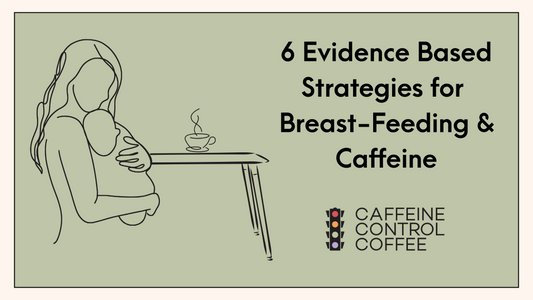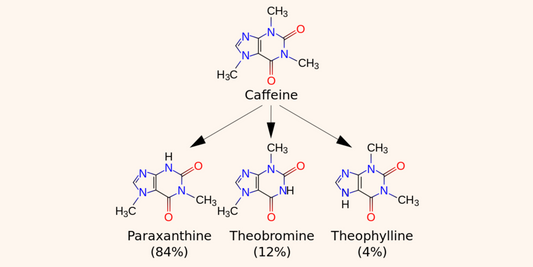How Much Caffeine Gets Transferred to Breast Milk
When we talk about caffeine and breastfeeding, it’s essential to know that only a small percentage of the caffeine we drink actually makes it into breast milk. According to Berlin et al. (1984) and the American Academy of Pediatrics (2001), around 0.5% to 1.5% of the caffeine a mother consumes gets transferred. For a single 10g serving (125mg caffeine) of our Full Speed Blend, that means your baby could be getting between 0.625mg and 1.875mg per serving. It’s a small amount on paper, but that’s only part of the story.
How Much Caffeine Would a Baby Potentially Ingest?
If you’re enjoying your morning routine and having 2 servings a day (or 250mg of caffeine), that caffeine finds its way, little by little, into your breast milk. An average baby drinking milk after you had those 2 servings would end up consuming anywhere from 1.25mg to 3.75mg of caffeine per day. Again, that may seem like a tiny number compared to your cup, for a tiny body that can be a lot.
Timing of Caffeine Transference into Breast Milk
The story doesn’t end there. Berlin et al. (1984) reported that caffeine shows up in breast milk surprisingly quickly - within just 15 minutes to 2 hours after you’ve had that cup. That’s why timing your coffee intake and considering your baby’s sensitivity is so important.
Purkiewicz et al. (2022) also reported that higher aged women from urban centres were found to have more caffeine in their milk, and that caffeine transference differed depending on the stage of lactation.
In the study, the 1st stage of lactation (colostrum production) had notably less caffeine than the later stages. So caffeine transfer may not be a concern for the first week or nursing. By stage 3 lactogenesis, the amount of caffeine in milk is shown to increase by around 2.5x.
Caffeine Accumulation in Baby’s System
While the specific amount of caffeine that can be transferred from the mother to the baby is relatively small, it’s important to remember that babies process caffeine at a much slower rate than adults. As noted earlier, even small daily amounts (1.25mg to 3.75mg per day from 2 servings) can accumulate over time due to the baby’s slow caffeine metabolism (65-130 hours). And because newborns process caffeine very slowly - Natarajan et al. (2007) noted it can stick around in their system for 65 to 130 hours - even small daily amounts can add up. This means that it could take weeks to effectively eliminate all caffeine in a baby’s system.
So while a daily dose from 2 servings may seem low at first, over one week this amount can build up, and continued maternal consumption can cause even higher levels to accumulate over multiple weeks. What makes this especially tricky is that you may not see the effects of caffeine on your baby for days or even weeks, making it tough to correlate irritability with caffeine intake. Of course, babies go through times of irritability, restlessness, and poor sleep no matter what, but if you’ve been drinking coffee regularly and seeing increases in these symptoms, caffeine could be part of the problem.
This chart breaks down just how much caffeine could be in your baby’s system over time, assuming the mother is ingesting 400mg of caffeine and not adjusting any behavior:
|
Estimate Type |
Daily Intake |
Half-Life in Baby (Hours) |
Estimated Accumulated Caffeine After 7 Days |
14 Days |
21 Days |
|
Low Estimate |
2.0mg/day |
65 hours |
7.4mg |
8.6mg |
8.8mg |
|
Average |
4.0mg/day |
97.5 hours |
17.8mg |
23.2mg |
24.8mg |
|
High Estimate |
6.0mg/day |
130 hours |
29.6mg |
41.6mg |
46.6mg |
This highlights why moderation is recommended, especially in newborns with slower caffeine metabolism.
Clearly, the lower estimates are more manageable. For this reason, we have put together some strategies for minimising caffeine that can get transferred to your baby.
6 Strategies for Nursing Mothers
1. Moderate Intake
Limit to the recommended 200mg caffeine daily. This can be achieved through fewer cups, weaker coffee (less dry coffee & more water), or well formulated blends. Staying under 200mg is one of the best steps in preventing excess caffeine transfer.
2. Consider your diet
Increase your (the mother’s) intake of cruciferous vegetables like broccoli, cabbage, and cauliflower, as well as grilled meats, which increase your body’s CYP1A2 enzyme. This enzyme is responsible for the metabolism of caffeine. The faster you metabolize caffeine, the less is potentially in breast milk for your baby.
3. Timing
Drink coffee immediately after breastfeeding to allow time for caffeine levels to decline before the next feed. If expressing milk, time your coffee in the last 5-10 minutes of pumping and immediately after. Caffeine levels in breast milk decrease around 1-2 hours after consumption, and caffeine continues to decrease after 3 hours. Be careful though, because caffeine metabolites will still be present.
4. Monitor Infant
Watch for signs of caffeine sensitivity (e.g., irritability, poor sleep) and adjust intake accordingly. While the danger for extreme reactions is low, sleep and comfort are valuable for both the baby and the parents. Keeping a journal of when you are having coffee, or at least when you changed intake patterns, can help tell if caffeine may be building up in your baby's system.
5. Consider Low Caffeine, Decaf, or eliminating coffee
If you are concerned, choose decaf and low-caffeine alternatives. Water-processed decafs will have the lowest levels of caffeine. Low caffeine blends are ideal for moderating and controlling quantity. If all else fails and you are still concerned, cutting out coffee entirely may be warranted. Coffee substitutes may also help, but make sure they don't contain compounds that could affect your baby as well.
6. Don’t forget Tea and Chocolate
Don’t forget that chocolate contains caffeine and theobromine (one of caffeine’s breakdown components). A 100g dark chocolate bar can have as much as 84mg caffeine. Tea is another major source of caffeine, and depending on the type you drink, the caffeine can add up. Green and white tea have low amounts (15-30mg), while black teas have more (30-50mg). Yerba Mate, while considered an “herbal” tea, has the most (40-80mg). If you drink coffee and tea, and have some chocolate each day, your caffeine intake can really start to add up. Just keep this in mind if you enjoy them!
Sticking to a lower intake, around 200mg or less of caffeine per day from all sources, and using the timing strategies and possible boosts to your liver enzymes, you should be closer to the following chart:
|
Estimate Type |
Daily Intake |
Half-Life in Baby (Hours) |
Estimated Accumulated Caffeine After 7 Days |
14 Days |
21 Days |
|
Low Estimate |
1mg/day |
65 hours |
3.7mg |
4.3mg |
4.4mg |
|
Average |
2mg/day |
97.5 hours |
8.9mg |
11.6mg |
12.4mg |
|
High Estimate |
3mg/day |
130 hours |
14.8mg |
20.8mg |
23.3mg |
The average estimate only gets to 12.4mg, which should be tolerable for most babies. Again, if you are concerned it is better to cut back.
This is not medical advice, not are we medical practitioners. Our approach is in minimising what is already in most peoples' diet to get better results. Always ask your doctor for official medical advice or if you plan to add new items to your diet.
The Good News
First of all, we want you to know that caffeine is not a high risk compound for babies. It is even used in NICU wards to help premature babies overcome breathing problems! So don't stress if you had a bit more coffee every once in a while.
Also, while the concern of caffeine for your new baby can seem stressful, babies will start processing caffeine at the same level as adults by 12-18 weeks of age and have even been reported to eliminate caffeine even faster than adults for some time.
So the great news is that the concern of caffeine with breastfeeding is usually short lived!
From around the 2nd trimester of pregnancy until the baby is roughly 3 months old are the prime times that you should consider reducing caffeine intake, and our coffees are designed to let you do so without the guesswork and pain of another sacrifice for the good of your baby.
Whether you completely cut coffee, drink decaf, or choose a low caffeine blend (ours or one from your local roaster), we hope that this knowledge will help you get results with ease.
References
(Most links are to abstracts. Full articles may require paid access)
Purkiewicz et al. (2022). Nutrients, 14(11), 2196. PMC9182860.
Natarajan et al. (2007). Clin Perinatol, 34(1):93-104. doi:10.1016/j.clp.2006.12.005.
Berlin et al. (1984). Pediatrics, 73(1):59-63.
AAP Committee on Drugs (2001). Pediatrics, 108(3):776-789. doi:10.1542/peds.108.3.776.
Aranda JV, Collinge JM, Zinman R, Watters G. Maturation of caffeine elimination in infancy. Arch Dis Child. 1979 Dec;54(12):946-9. doi: 10.1136/adc.54.12.946. PMID: 533298; PMCID: PMC1545746.




